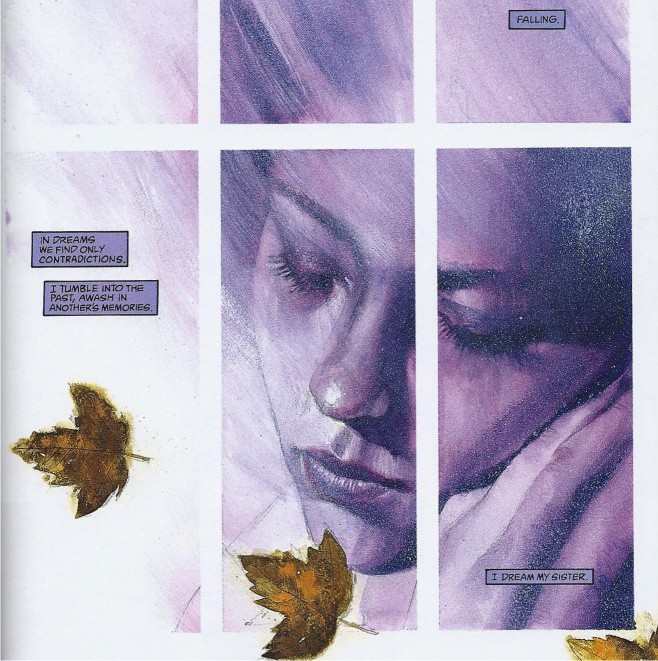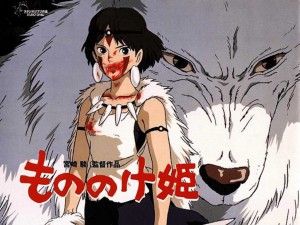This is easily the darkest of Miyazaki’s films, dark not only in the sense of the themes but also in that most of the film seems to happen in a twilight world, with little or no sunlight. Probably because most of the proceedings unfold inside forest canopies. The climax involves the morning sun, but the tension onscreen, with a decapitated being groping around for his head, negates its effect.
While Spirited Away had cute and quirky forest gods with the occasional gross-out creature thrown in, Mononoke’s menagerie of beings fall squarely on the malevolent side of the supernatural spectrum. The worm-infested Tatari-gami that attacks Ashitaka’s village in the opening sequence, San’s guardian wolf-god (goddess?) Moro, the Ape gods that demand to eat human flesh – these are some scary, no-nonsense creatures. Even the benevolent deer god is a death-deity in his night-walker form.
And the kodamas? They are cute, I agree, but the clattering is fucking creepy, man. A lot of things in the film are fucking creepy. Like the part where Jiko’s men follow the wounded boar god as he stumbles blindly towards the Shishigami’s island, slithering alongside him wearing the skins of dead boars. Or the first time we see San, her face smeared in red, a feral creature of the woods. She spits out blood, and stares at the camera. Creepy.
Mononoke is also unique in the sense that it is an action movie from the Ghibli stable, and a period action movie at that. The violence is served without mercy – bullets and arrows whiz towards their targets with precision, blood flows freely, body parts fly sans concern for parental guidelines. The fight sequences are brutal and gravity-defying – San and Ashitaka’s rooftop confrontation, or the wolves leaping across jagged cliffs to strike at Eboshi’s procession. The final onslaught of the boars against the humans is a harrowing scene of destruction that makes you want to look away. Hisaishi’s score reflects the turmoil of the battlefields, one that booms to taiko drums and echoes through deep, rippling cello sweeps. There are brief moments of respite, like during the kodama sequences, but they are few and far between.
As always, it’s the details that get me. How the presence of Yakkul the elk (easily my favorite character in the movie) kind of nudges at the otherworldliness of the setting. The way we learn about Ashitaka’s outsider status (and that of his people) when he tries to buy food from a village market in course of his quest. Lady Eboshi is one fascinating non-villain, and you would be hard-pressed to really dislike her or not see things from her point of view. Mononoke, like most Ghibli films, has things to say about the relationship between mankind and nature, about co-existence and mutualism, and its lovely to see shades of grey abound in the story, instead of broad strokes of good vs evil.
The scene where Kaya, one of the girls in Ashitaka’s village gives him her Gyoku no Kogatana (and the subs say “obsidian knife”) made me smile, because I remembered suddenly the name of the gentleman who had written the dialogues for the English version. He was not as well-known then as he is now, but I remember reading his discussion about why he chose the word “obsidian” instead of something more generic, like “jade”. His name was Neil Gaiman. He wrote the dialogues to make the film, soaked in details and minutiae of Japanese folklore, more accessible to Western audiences. One such changed detail that came to mind was the voice of Moro. Japanese culture has male voices for wolves, regardless of gender – and it comes as a shock to a first-time non-Japanese viewer (umm, me, circa 2004) when you realize that San calls Moro “mother”. To remedy that, Gillian Anderson voiced her in the American dub.
While I really did not remember much of the film from my eight-year-old viewing, the memory of one particular scene lingered, and I looked forward to see how my perception of it would be altered when I saw it now. That scene – in which the deer god appears for the first time, and makes his way towards the wounded Ashitaka on the island, flowers blooming and withering in his wake – occurs in perfect silence. When it played on my PC, I was half-tempted to check if the sound system had conked off. If I remember right, the Weinsteins tried to introduce a musical score in this sequence for the US release just because audiences weren’t used to absolute silence – Miyazaki refused, obviously. I am not sure how Americans watching it in theaters in the early 2000s took it. But in the Egyptian that night, when the deer god made his appearance, I realized two things – one, I was holding my breath. And two, so was everyone else in the theater. The guy two seats away from me, who had been wheezing until then, had fallen silent. The gang of students giggling behind me, ditto. No popcorn being chewed, or shoes shuffling in the dark, or creaking seats. Have you ever been in a packed theater that has fallen silent at the right cinematic moment?
That was something to remember.

